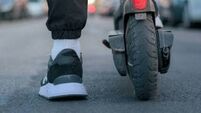Shortcut
How else to explain David Beckham’s wristwatch?
However, it’s not always a matter of bling. Sometimes, what looks like a stylish finish is actually the result of science.
Take the case of a titanium necklace.
True, it’s not the most decorative piece you could throw on for an elegant evening out — though the manufacturers are branching into other metallic colours — but it might just help overcome the drudgery of physical training: you can Join Ernie Els, Randy Johnson and Paula Radcliffe in donning a Phiten titanium necklace and watch your sporting performance improve.
The science? The manufacturer claims the necklace improves circulation and reduces muscle stress by controlling electricity flow in the body. Seriously.
“Everyone has electricity running through their body,” says Scott McDonald, Phiten’s Seattle-based sales and marketing representative. “This product stabilises that flow of electricity if you’re stressed or tired.”
Don’t laugh — it’s estimated more than 200 major league baseball players have indulged in a Phiten necklace, and they can’t all be wrong.
However, if you’re still sceptical, you could join the Brisbane Lions (an Australian Rules football team) and Aussie boxer Kostya Tszyu. They’re are all using Lact-Away, a magic potion derived from the bark of a French pine tree.
It’s expensive and it tastes putrid — which is no real surprise.
The potion was originally developed in the US to prevent muscle fatigue in racing horses by reducing lactic acid. And when we say expensive, we mean it: a 940ml bottle costs AU$300.
Your average junior footballer might balk at the price, but the product’s Australian manufacturers are eyeing lucrative markets. They’re already negotiating with the Chinese Sports Ministry and have European football teams in their sights.
Lactic acid is also the focus of our next device, one aimed at straight at hard-core aerobic athletes. They can self-administer the Lactate Pro pin-prick test on the field, then track their lactic acid levels to optimise endurance.
The device, the smallest of its kind, is approximately the size of a credit card and weighs only 50g; it requires only a tiny drop of blood and takes 60 seconds to measure muscle fatigue.
It works, too, according to a recent article in British Triathlon magazine: “The lactate analyser market in Australia has recently been significantly improved with the addition of the Lactate Pro. It has a number of features, which set it apart from its competitors and make it ideal to be used by the triathlon market.”
Though the mind boggles at the thought of the “lactate analyser market”, the write-up is a glowing endorsement; what’s not so glowing is the price, US$475.
If that’s too expensive, try cashews — double gold medal-winner Kelly Holmes swears by the nuts, and is proof of the facts.
A small 50g serving of cashews provides one-fifth of a woman’s daily iron requirements and around one-tenth of a man’s zinc needs.
Experts say all nuts are a rich source of protein, which enhance muscle recovery after intense activity. Nuts also provide carbohydrates and essential minerals, including potassium lost in sweat. This makes them an ideal snack for anyone after a workout.
However, this isn’t to say all natural products are good.
For instance, athletes are constantly warned to avoid dehydration, with marathon runners in warm climates urged to take particular care. And while bottled water may be ever-present wherever runners go, it’s possible they end up drinking so much that they actually dilute their blood.
The science? All runners are encouraged to hydrate, but what some don’t realise is that it’s also vital to maintain a proper sodium balance. This makes for healthy cells.
Runners can dangerously dilute their sodium levels if they drink too much. The resulting condition is known as hyponatremia — too much water.
The official advice given to participants in the New York City Marathon is to drink no more than eight ounces of water every 20 minutes — its a warning taken seriously since the 2003 death of Cynthia Lucero while running the Boston Marathon.
However, it’s not all doom and gloom for runners. They can still look natty, even while they sweat gallons as they trot around the track.
For instance, top athletes Paula Radcliffe and Jo Pavey swear by compression socks.
According to the manufacturer of Oxysox — the only brand aimed specifically at sportspeople — its knee-length stockings apply pressure to the lower leg, starting at the foot and stopping at the calf. This allows a rapid return of blood to the heart and lungs and results in improved circulation. The stockings are also said to limit wasted muscle motion, reduce fatigue and allow a quicker recovery from exercise.
The expert verdict is that while they might be helpful for marathon runners, there’s no clinical evidence they improve everyday performance. But think of the upside — you look terrific.
And talking of looking good, you can always follow the AC Milan footballers.
The MaxSight contact lens — a new technology produced by Nike in conjunction with Bausch & Lomb — is intended to take performance sportswear into yet another era.
Developed over eight years, the lenses are designed to improve an athlete’s “visual acuity” (sharpness of vision).
The lenses are being tested by AC Milan and use what the manufacturers call “architecture optics” to filter specific light wavelengths and “enhance key visual elements”, such as a ball or a background. They also reduce glare.
The manufacturer sought a vision consultant to develop amber lenses for tennis, football and rugby players, and grey lenses for runners, cricketers and golfers. According to the marketing literature, both colours “make the eye look competitive” — they supposedly make the wearer look scary to freak out their opponent.
For traditionalists, the Robbie Fowler nasal strip is still on the market.
Originally developed to help people with conditions like excessive snoring and sleep apnoea, Breathe Right nasal strips have recently gained in popularity among sportspeople who believe they improve airflow from the nasal passage to the lungs.
However, experts aren’t so sure of the benefits; while acknowledging the strips may improve airflow through the nose, there’s no evidence that air actually reaches the lungs and goes on to boost performance.
Our favourite sports science product is the new Suunto G6 watch, which enables golfers to perfect their swing.
Players can instantly check their tempo, rhythm, length and speed — helping to identify the best shots and develop the muscle memory to repeat them. After the session, players can also analyse their overall consistency.
The Suunto website says “more than two years of development and research were needed to integrate three acceleration sensors in the lightweight (55g/1.92 oz) Suunto G6 watch. As this watch measures the movement of your wrist at 200 times a second, with extremely high accuracy, it is called a wrist-top computer ... A pro’s tempo is between 0.9 and 1.3 seconds. You might be slower because of age or fitness, but tempo also relies on the rhythm of your swing”.
The Suunto G6 will be available at the end of the year.
Apparently, if you want, it can also tell you the time.














